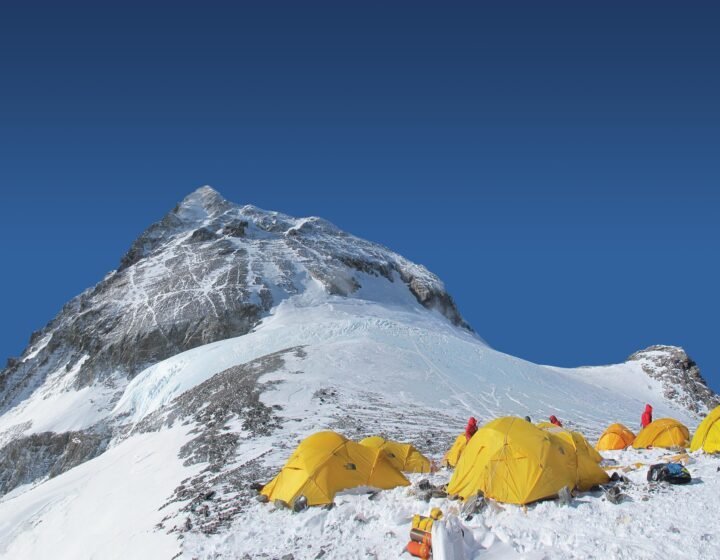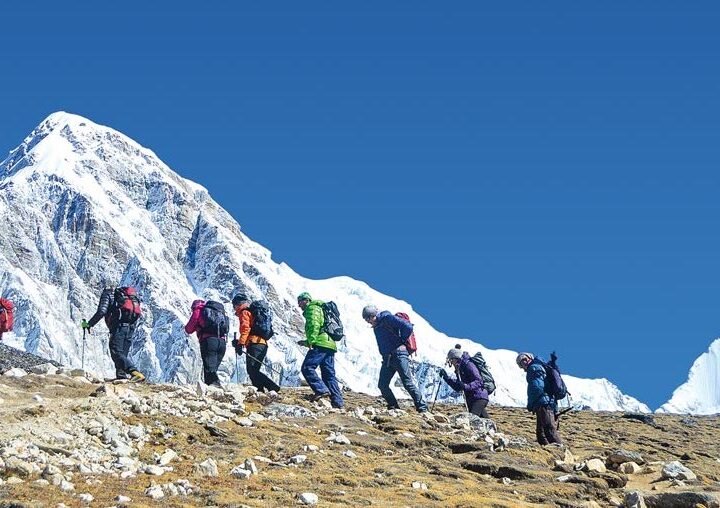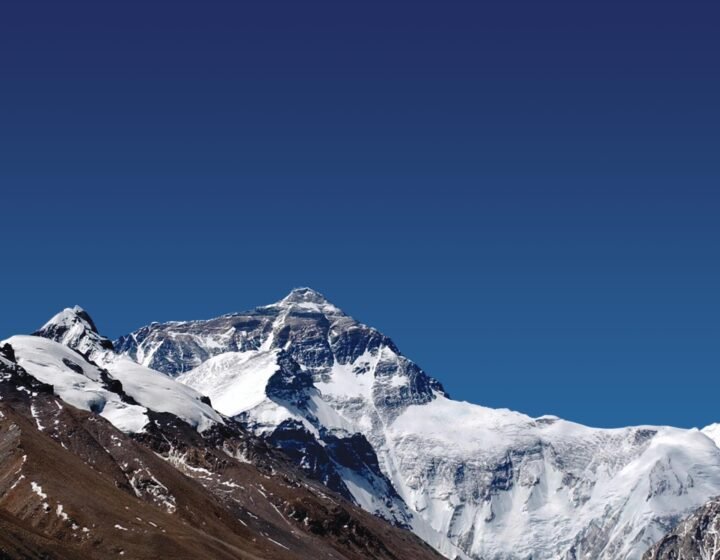- Details
Detailed itinerary
Itinerary- Tour Includes/Excludes
- Useful Info
- Trip Map
- FAQ
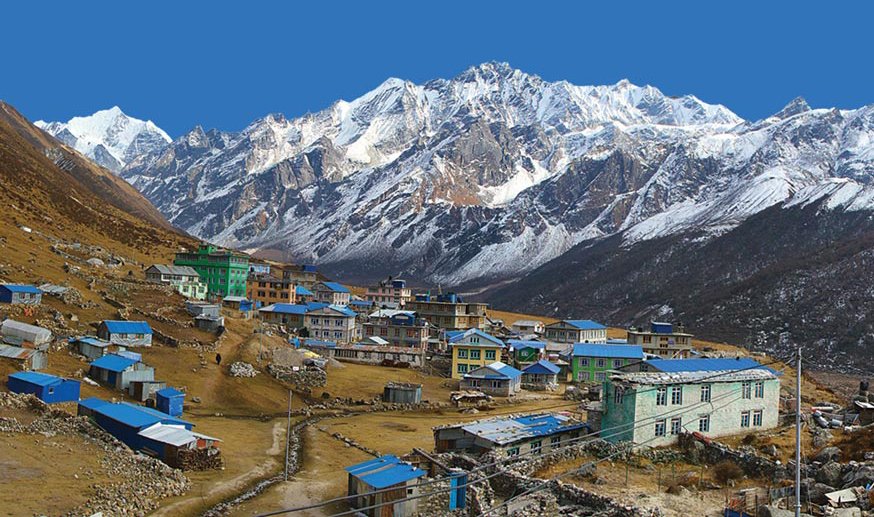
Trip overview
The Gosainkunda Short Trek is a classic blend of religious beliefs and gorgeous landscapes, leading trekkers over stunning mountaintops, charming trees, flowing waterfalls, and, most significantly fantastic vibes. The Gosainkunda Lakes are in the Langtang region.
Gosainkunda Lakes is a common pilgrimage trek that is 4,380 meters above sea level. It is believed that Lord Shiva created Gosainkunda Lake by plunging his trident into a mountain in search of water. According to folklore, Gosainkunda cleanses all the sins of those who bathe in it. In addition, other prominent lakes in the Gosainkunda Lake include Saraswatikunda, Bhairabkunda, Nagkunda, and Surajkunda.
The trail winds through deep rhododendron forests on both sides of the river until it bursts through the tree line and heads into the alpine regions. During the trail, It passed the glacial moraine and reconstructed village of Langtang. The yak pasturelands and stunning environment of Kyanjin Gompa, a secluded monastery noted for the manufacturing of yak cheese, are farther and higher into the valley’s inner sanctuary. Climbs to Kyanjin Ri or Cherko Ri provide panoramic views of the surrounding mountains, notably Langtang Lirung, which dominates the valley at 7234 meters.
Returning to the trailhead, the Gosaikunda route proceeds southeast, climbing steeply through terraced farms to magnificent highlands with views of distant peaks like Manaslu (8163m) and the Tibetan plateau to the north. The trek then continues to Gosaikunda and the sacred lake of Gosaikunda, a calm mountain valley that adds to the spectacular view of the distant Himalayan peaks. During Janai Purnima, Hindus flock to the region to pay tribute to a spot believed to have been Shiva’s temporary residence, and the area becomes a prominent pilgrimage site.
Trekkers will also get the chance to visit local Tamang communities and learn about their distinct cultures and customs. Because the Tamang ethnicity dominates the Langtang region, you will be steeped in their culture and customs. These people are kind since Tibetan customs influence their way of life. The Himalayan people are kind and helpful in nature. Like Hindus, they treat their guest as gods and they do everything that makes their guests happy. They emphasize the demands and comforts of visitors over anything else.
Langtang Highlights:
- This is an excellent alternative walk to the popular routes in the Annapurna and Everest regions.
- It starts with an exciting drive to the trip starting point View the Himalayas from the famous Tserko Ri viewpoint.
- Tamang customs and traditions are rich in Tibetan influences.
Itinerary
Day 1: Arrival at Kathmandu and serve an authentic Nepali dinnerOur one team member will meet you at the airport and receive you from there. You will be welcomed with warm, delicious food and a cultural program.
Visit several stupas and local markets in the Kathmandu valley and be prepared with your backpacks and all necessary gear.
An early departure for Sybrubesi, with a maximum drive time of eight hours to the trek's starting point. It provides a spectacular view of the Himalayas, including Ganesh Himal. The first Langtang National Park entry point is before the district headquarters of Dhunche.
The Tibetan-influenced village with flat-roofed houses and a stunning view of Langtang Lirung (7,225 m) is the first thing that catches the eye after obtaining a permit for the Langtang region. The risk of AMS (Acute Mountain Sickness) and encounters with mild AMS symptoms increases as altitude increases. Visit the "factory," which was founded in 1904 by the Swiss Association for Technical Assistance, and sample the excellent and organic Yak cheese.
These hills offer views of panoramic snowy mountains. An ascent of Tserko Ri (4,984 m) is an option for a personal fitness challenge. An enthusiastic hiker ascends the nearby Ubra glacier.
The hike from Kyanjin Gompa to Thulo Syabru contains irregular geographical patter of trial which might be risk while climbing and down stepping.
Thulo Syabru village has grown along a long ridge, with all houses set against the backdrop of snow-capped peaks. The trek is made even more memorable by the charming and friendly locals.
The climb to Foprang Danda is difficult, but the views from the top are spectacular. The trail to Singompa is almost level after Foprang Danda. Visit the Singompa cheese factory and the monastery, which have a dark interior blackened by years of burning candles. A torch will illuminate the colorful wall paintings of gods, goddesses, and demons. The central western Himalayan ranges are now accessible, including Ganesh Himal (7,406 m), Manaslu (8,156 m), and the Annapurna. The holy Gosaikunda lakes are the destination of Hindu pilgrims who make the journey barefoot and in little more than thin cotton clothing during the full moon in August each year.
The path up to the pass is clearly marked with cairns, and once at the summit (4,610 m), there is a good view of the adjoining valleys. A long and strenuous day crossing the Laurebina Pass into the idyllic Helambu Valley. Although the pass is not technically difficult, snow and ice can make the walking more difficult. However, the views are spectacular. After a long day, you arrive at Ghopte (3,530 m) and have time to reflect on your accomplishments.
At Tharepati, a group of herders' huts at 3,490 meters with good views down into the Helambu valley and across to the Solu Khumbu region's Jugal Himal and Numbur, it's making its way down to Pati Bhanjyang, a large Tamang village with a small town and a police checkpoint. It's a 2-hour climb from here to Chisopani, where you'll spend the night. The trail passes the National Army checkpoint before climbing to the Burlang Bhanjyang Pass ridge, which marks the northern rim of the Kathmandu valley. Views are spectacular, from Annapurna in the west to Ganesh Himal and Numbur in the east. Pass through the Sundarijal water reservoir for the Kathmandu Valley, then follow a large water supply pipe until it ends in the market. Return transportation to the Kathmandu hotel.
On the last leg of the trip, our agent will pick you up from the airport and drop you off at the airport with all your belongings safely.
Included
- Hotel stays and food (Breakfast, Lunch, Dinner, Drinking water, Tea/coffee) during the itinerary.
- Customized transportation facilities
- Langtang Trekking permit, as well as entry costs to the Langtang National Park.
- Full board meals when trekking to Langtang Gosaikunda.
- Free use of high-quality hiking equipment such as a sleeping bag, fleece liner, down jacket, rain poncho, and so on during the trip.
- Comfortable rooms at tea houses or lodges during the trek.
- Expert crew members with proper gear and insurance
- Professional tourist guide with a First Aid box.
Not Included
- International Airfare for any travelers
- Travelling insurance
- Visa fee to Nepal
- Meal and drinks which are not mentioned in the Package
- Personal belongings such as phone calls, laundry, extra snacks, drinks, etc.
Useful Info
- All foreign travelers must share their personal (visas and passport) details while booking and arriving.
- Expect all trekkers not to bring any non-biodegradable product
- Intoxicating drugs and alcohol consumption are completely restricted during trekking
- Recommended keeping cash because in the upper Langtang region you will not find ATM facilities to withdraw your cash.
- Chances of dehydration at higher altitudes so, make sure to consume water in a regular manner and bring extra bottles with you.
- Recommendation to keep a buffer day to deal with the uncertain event
- All tourists are required to keep their passport or visa with the traveling agencies
- Layering clothes is the best approach to maintain your body temperature while trekking at higher altitudes, thus zippered wears are the best alternative.
- Because mobile phone and camera batteries are prone to going dead or losing power quickly, a portable charger is an absolute necessity for your electronic devices.
Trip Map
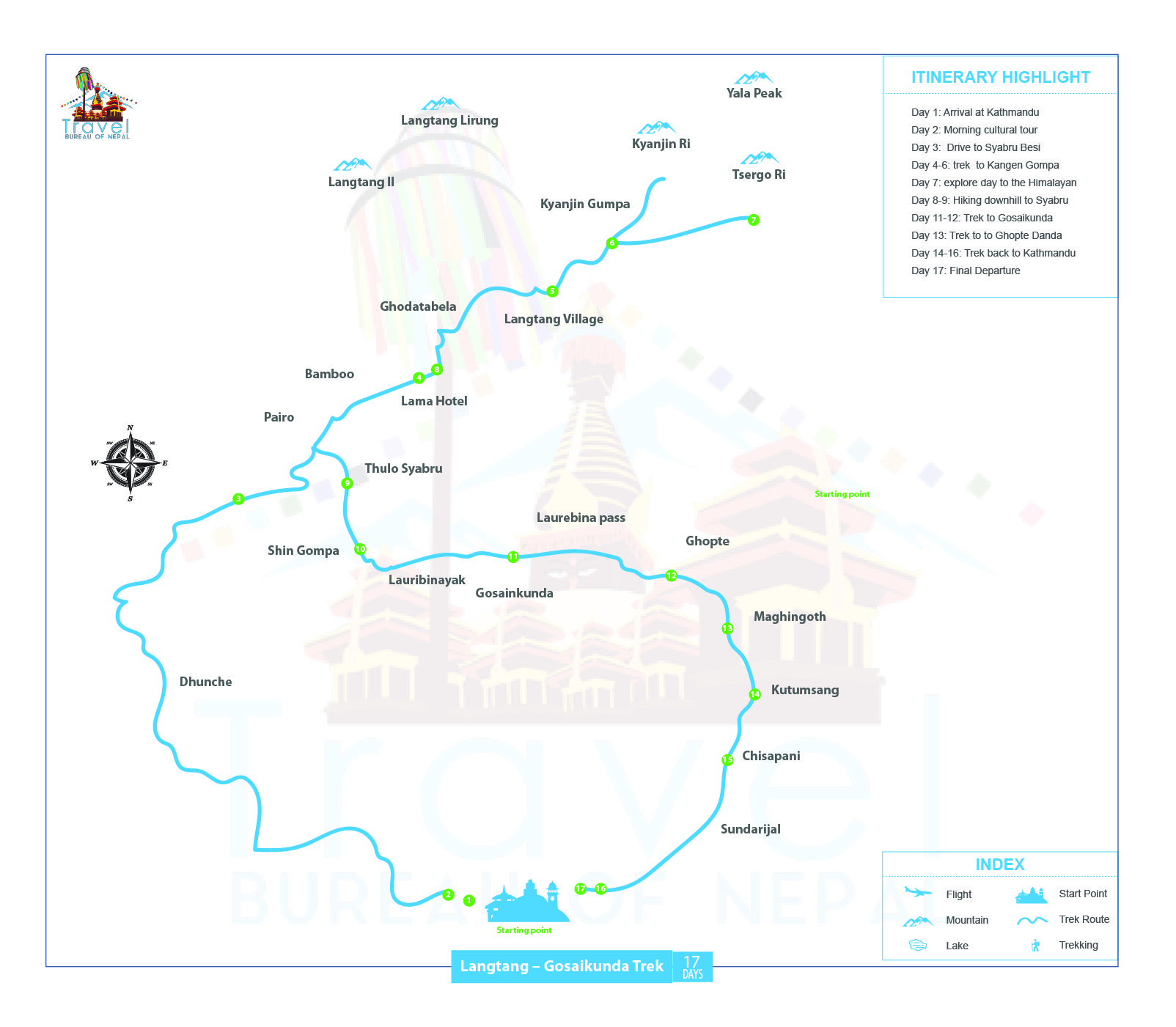
FAQs
-
What are the main attractions of the Gosaikunda trek?
The 108 lakes, a sacred location for both Hindus and Buddhists, are the trek's main attraction. Aside from that, the trek provides a spectacular view of the Himalayan mountains on the opposite side. Mt. Manaslu, Ganesh Himal, the Langtang mountain range, and border mountains are all part of the Himalayan picture. A stunning sunset may be seen from the edge of Gosaikunda. In terms of hiking, the Pilgrimage to Gosainkunda is a great experience. The cheese factory in Chandanbari makes delicious Yak cheese. It is the ideal keepsake to bring home.
-
Is particular training required to hike the Gosaikunda Lake trail?
The Gosaikunda Lake path does not require any specific climbing or mountaineering skills. It is a somewhat easy hike. You may enjoy your pleasant walk by jogging or walking routines to maintain your muscles fit. It prepares your body for a couple of days of high-altitude climbing.
-
What about the weather and temperature in Gosaikunda?
Because to its Alpine character, the weather near Gosaikunda changes often. During the late spring, it is often damp and hazy in the afternoon, with frequent rain. The winter is dry, bright, and clear. You should check the weather forecast before embarking on the hike. It is also strongly advised to look for sensible packaging.
-
Can I combine the Gosainkunda and Langtang Valley treks?
Adding extra days to the Gosaikunda trek plan allows you to see Langtang Valley. The Langtang Valley hike may be extended by 5 days. Begin in Syabrubensi and continue the trail to the valley, passing via the Lama hotel. The major settlements along the road are the magnificent Langtang Valley and Kyanging village. Retrace your steps up to Pahiro and ascend to the Thulo Syabru. The route from Thulo Syabru connects with the Dhunche trail to the Gosaikunda Lake trail near Chandanbari.
-
When is the Best Time to Visit Gosaikunda?
Because the walk to Gosaikunda is often influenced by the weather, receive the latest information. In general, the optimum seasons for walking the Gosaikunda are autumn (September-November) and spring (March-May). From June through August, the journey may be hampered by pre-monsoon and monsoon rains. Trek during the winter to avoid heavy traffic but be prepared for freezing temperatures and a clear sky. The monsoon season is ideal for photography. The bright blooms of alpine pastures are appealing to botanists.

